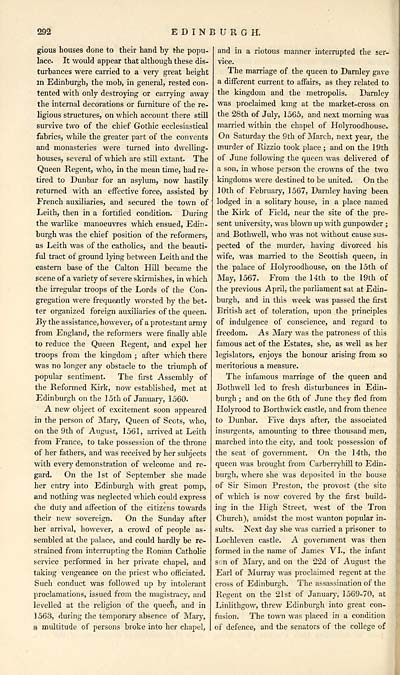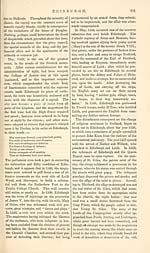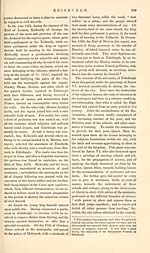Gazetteer of Scotland > Volume 1
(326) Page 292
Download files
Complete book:
Individual page:
Thumbnail gallery: Grid view | List view

292
EDINBURGH.
gious houses done to their hand by the popu-
lace. It woidd appear that although these dis-
turbances were carried to a very great height
m Edinburgh, the mob, in general, rested con-
tented with only destroying or carrying away
the internal decorations or furniture of the re-
ligious structures, on which account there still
survive two of the chief Gothic ecclesiastical
fabrics, while the greater part of the convents
and monasteries were turned into dwelling-
houses, several of which are still extant. The
Queen Regent, who, in the mean time, had re-
tired to Dunbar for an asylum, now hastily
returned with an effective force, assisted by
French auxiliaries, and secured the town of
Leith, then in a fortified condition. During
the warlike manoeuvres which ensued, Edin-
burgh was the chief position of the reformers,
as Leith was of the catholics, and the beauti-
ful tract of ground lying between Leith and the
eastern base of the Calton Hill became the
scene of a variety of severe skirmishes, in which
the irregular troops of the Lords of the Con-
gregation were frequently worsted by the bet-
ter organized foreign auxiliaries of the queen.
By the assistance, however, of a protestant army
from England, the reformers were finally able
to reduce the Queen Regent, and expel her
troops from the kingdom ; after which there
was no longer any obstacle to the triumph of
popular sentiment. The first Assembly of
the Reformed Kirk, now established, met at
Edinburgh on the 15th of January, 1560.
A new object of excitement soon appeared
in the person of Mary, Queen of Scots, who,
on the 9th of August, 1561, arrived at Leith
from France, to take possession of the throne
of her fathers, and was received by her subjects
with every demonstration of welcome and re-
gard. On the 1st of September she made
her entry into Edinburgh with great pomp,
and nothing was neglected which could express
che duty and affection of the citizens towards
their new sovereign. On the Sunday after
her arrival, however, a crowd of people as-
sembled at the palace, and could hardly be re-
strained from interrupting the Roman Catholic
service performed in her private chapel, and
taking vengeance on the priest who officiated.
Such conduct was followed up by intolerant
proclamations, issued from the magistracy, and
levelled at the religion of the queen, and in
1563, during the temporary absence of Mary,
a multitude of persons broke into her chapel,
and in a riotous manner interrupted the ser-
vice.
The marriage of the queen to Darnley gave
a different current to affairs, as they related to
the kingdom and the metropolis. Darnley
was proclaimed king at the market-cross on
the 28th of July, 1565, and next morning was
married within the chapel of Holyroodhouse.
On Saturday the 9th of March, next year, the
murder of Rizzio took place ; and on the 19th
of June following the queen was delivered of
a son, in whose person the crowns of the two
kingdoms were destined to be united. On the
10th of February, 1567, Darnley having been
lodged in a solitary house, in a place named
the Kirk of Field, near the site of the pre-
sent university, was blown up with gunpowder ;
and Bothwell, who was not without cause sus-
pected of the murder, having divorced his
wife, was married to the Scottish queen, in
the palace of Holyroodhouse, on the 15th of
May, 1567. From the 14th to the 19th of
the previous April, the parliament sat at Edin-
burgh, and in this week was passed the first
British act of toleration, upon the principles
of indulgence of conscience, and regard to
freedom. As Mary was the patroness of this
famous act of the Estates, she, as well as her
legislators, enjoys the honour arising from so
meritorious a measure.
The infamous marriage of the queen and
Bothwell led to fresh disturbances in Edin-
burgh ; and on the 6th of June they fled from
Holyrood to Borthwick castle, and from thence
to Dunbar. Five days after, the associated
insurgents, amounting to three thousand men,
marched into the city, and took possession of
the seat of government. On the 14th, the
queen was brought from Carberryhill to Edin-
burgh, where she was deposited in the house
of Sir Simon Preston, the provost (the site
of which is now covered by the first build-
ing in the High Street, west of the Tron
Church), amidst the most wanton popular in-
sults. Next day she was carried a prisoner to
Lochleven castle. A government was then
formed in the name of James VI., the infant
son of Mary, and on the 22d of August the
Earl of Murray was proclaimed regent at the
cross of Edinburgh. The assassination of the
Regent on the 21st of January, 1569-70, at
Linlithgow, threw Edinburgh into great con-
fusion. The town was placed in a condition
of defence, and the senators of the college of
EDINBURGH.
gious houses done to their hand by the popu-
lace. It woidd appear that although these dis-
turbances were carried to a very great height
m Edinburgh, the mob, in general, rested con-
tented with only destroying or carrying away
the internal decorations or furniture of the re-
ligious structures, on which account there still
survive two of the chief Gothic ecclesiastical
fabrics, while the greater part of the convents
and monasteries were turned into dwelling-
houses, several of which are still extant. The
Queen Regent, who, in the mean time, had re-
tired to Dunbar for an asylum, now hastily
returned with an effective force, assisted by
French auxiliaries, and secured the town of
Leith, then in a fortified condition. During
the warlike manoeuvres which ensued, Edin-
burgh was the chief position of the reformers,
as Leith was of the catholics, and the beauti-
ful tract of ground lying between Leith and the
eastern base of the Calton Hill became the
scene of a variety of severe skirmishes, in which
the irregular troops of the Lords of the Con-
gregation were frequently worsted by the bet-
ter organized foreign auxiliaries of the queen.
By the assistance, however, of a protestant army
from England, the reformers were finally able
to reduce the Queen Regent, and expel her
troops from the kingdom ; after which there
was no longer any obstacle to the triumph of
popular sentiment. The first Assembly of
the Reformed Kirk, now established, met at
Edinburgh on the 15th of January, 1560.
A new object of excitement soon appeared
in the person of Mary, Queen of Scots, who,
on the 9th of August, 1561, arrived at Leith
from France, to take possession of the throne
of her fathers, and was received by her subjects
with every demonstration of welcome and re-
gard. On the 1st of September she made
her entry into Edinburgh with great pomp,
and nothing was neglected which could express
che duty and affection of the citizens towards
their new sovereign. On the Sunday after
her arrival, however, a crowd of people as-
sembled at the palace, and could hardly be re-
strained from interrupting the Roman Catholic
service performed in her private chapel, and
taking vengeance on the priest who officiated.
Such conduct was followed up by intolerant
proclamations, issued from the magistracy, and
levelled at the religion of the queen, and in
1563, during the temporary absence of Mary,
a multitude of persons broke into her chapel,
and in a riotous manner interrupted the ser-
vice.
The marriage of the queen to Darnley gave
a different current to affairs, as they related to
the kingdom and the metropolis. Darnley
was proclaimed king at the market-cross on
the 28th of July, 1565, and next morning was
married within the chapel of Holyroodhouse.
On Saturday the 9th of March, next year, the
murder of Rizzio took place ; and on the 19th
of June following the queen was delivered of
a son, in whose person the crowns of the two
kingdoms were destined to be united. On the
10th of February, 1567, Darnley having been
lodged in a solitary house, in a place named
the Kirk of Field, near the site of the pre-
sent university, was blown up with gunpowder ;
and Bothwell, who was not without cause sus-
pected of the murder, having divorced his
wife, was married to the Scottish queen, in
the palace of Holyroodhouse, on the 15th of
May, 1567. From the 14th to the 19th of
the previous April, the parliament sat at Edin-
burgh, and in this week was passed the first
British act of toleration, upon the principles
of indulgence of conscience, and regard to
freedom. As Mary was the patroness of this
famous act of the Estates, she, as well as her
legislators, enjoys the honour arising from so
meritorious a measure.
The infamous marriage of the queen and
Bothwell led to fresh disturbances in Edin-
burgh ; and on the 6th of June they fled from
Holyrood to Borthwick castle, and from thence
to Dunbar. Five days after, the associated
insurgents, amounting to three thousand men,
marched into the city, and took possession of
the seat of government. On the 14th, the
queen was brought from Carberryhill to Edin-
burgh, where she was deposited in the house
of Sir Simon Preston, the provost (the site
of which is now covered by the first build-
ing in the High Street, west of the Tron
Church), amidst the most wanton popular in-
sults. Next day she was carried a prisoner to
Lochleven castle. A government was then
formed in the name of James VI., the infant
son of Mary, and on the 22d of August the
Earl of Murray was proclaimed regent at the
cross of Edinburgh. The assassination of the
Regent on the 21st of January, 1569-70, at
Linlithgow, threw Edinburgh into great con-
fusion. The town was placed in a condition
of defence, and the senators of the college of
Set display mode to: Large image | Transcription
Images and transcriptions on this page, including medium image downloads, may be used under the Creative Commons Attribution 4.0 International Licence unless otherwise stated. ![]()
| Gazetteers of Scotland, 1803-1901 > Gazetteer of Scotland > Volume 1 > (326) Page 292 |
|---|
| Permanent URL | https://digital.nls.uk/97428274 |
|---|
| Description | Volume I: Abbey to Glenartney. |
|---|---|
| Attribution and copyright: |
|
| Description | By Robert Chambers and William Chambers. Glasgow: Blackie & Son, 1838. 2 volumes. |
|---|---|
| Shelfmark | NF.1461.g.7 |
| Additional NLS resources: | |

